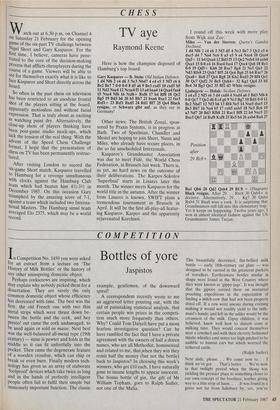COMPETITION
Bottles of yore
Jaspistos
In Competition No. 1459 you were asked for an extract from a lecture on 'The History of Milk Bottles' or the history of any other uninspiring domestic object.
Perhaps corkscrews are inspiring, which may explain why nobody picked them for a dissertation. They are surely the only common domestic object whose efficiency has decreased with time. The best was the first, the old French one with two thin metal strips which were thrust down be- tween the bottle and the cork, and hey presto! out came the cork undamaged, to be used again or sold en masse. Next best was the well-balanced all-metal type (19th century) — mine is pewter and folds in the middle so it can fit unfretfully into the Pocket. Then came the degenerate feature of a wooden crossbar, which can chip or break or even burn. Finally modern tech- nology has given us an array of elaborate `foolproof devices which take twice as long and in the hands of perfectly intelligent People often fail to fulfil their simple but immensely important function. The classic example, gentlemen, of the downward spiral!
A correspondent recently wrote to me an aggrieved letter pointing out, with the aid of painstaking statistical analysis, that certain people win prizes in the competi- tion much more frequently than others. Why? Could Tom Dalyell have put a more fearless investigative question? Can he have rumbled the fact that I have a private agreement with the owners of half a dozen names, who are all Methodist, homosexual and related to me, that,when they win they remit half the money (but not the bottle) back to Jaspistos? In choosing this week's winners, who get £10 each, I have naturally gone to insane lengths to appear innocent. The bonus bottle of gin, the gift of Mr William Topham, goes to Ralph Sadler, not one of the Mafia.
This beautifully decorated, flat-bellied milk bottle — early 18th-century cut glass — was designed to be carried in the greatcoat pockets of travellers. Earthenware bottles similar in shape were found in the West Country where they were known as `gippy-jugs'. It was thought that the gipsies carried these on nocturnal poaching expeditions in the expectation of finding a milch-cow that had not been properly dried off. If a cow were uneasy during evening milking it would not readily yield to the milk- maid's hands; and left in the udder would be the creamiest of the milk. Gipsy children, it was believed, knew well how to disturb cows at milking time. They would conceal themselves near a cowshed and with their cleverly fashioned thistle-whistles emit notes too high-pitched to be audible to human ears but which worried the tethered cattle.
(Ralph Sadler) Next slide, please. . . We come now to. . . I think we've got. . . That's better. . . We're now in that twilight period when the thong was yielding the premier place to something closer to our own concept of, the bootlace, leather giving way to a thin strip of linen. . . . It was found in a grave not far from Salisbury by, yes, you've guessed it, the indefatigable Archdeacon Win- der, rightly dubbed the Schliemann of the foot. As you can readily imagine, we at the Sock and Boot Research Institute were a-tiptoe with excitement when the find was reported. I'm afraid not much work got done that morning. Dr Gardiner remembered nothing like it since the discovery of the Rochdale sole. Next slide, please. . . . This is. . . yes, this is an artist's impression of the eye through which we think the Ur-lace I've just shown was meant to be threaded.
(Fergus Porter) By nine votes to five the Board decided to set up a committee to look into the prevalence of lukewarm tea and make recommendations for improvement. The chairman was George Tan- nam, a veteran tea-taster and a director of the East India Company. The membership compris- ed physicists, heating engineers, beverage wholesalers and a cup-and-saucer manufacturer. A tea-lady from the Treasury represented the Government.
The inquiry continued for three years (two million man-hours) and cost two million pounds. Six countries were visited, including the Amer- icas and China. Five subcommittees interviewed 838 people and drank over one thousand cups of tea. Six interim reports were issued (incorporat- ing 22 working papers).
Finally, a conference of scribes was arranged to make public the committee's findings. At the end of the proceedings a scribbler from Grub Street, who had been imbibing intoxicating liquors all day, threw his woollen cap in the air.
It landed on a teapot. (John O'Byrne) Friends: Last month I spoke to you on the History of Milk Bottles. Tonight I propose to speak on another invaluable and often disre- garded domestic object — the Sink Plunger. The Sink Plunger as we know it did not, of course, appear in our domestic quarters until after the introduction of the rubber plant from South America to the Malay States in the early years of this century. I shall be enlarging on this revolu- tionary development later in my lecture. In earlier, less civilised epochs the scullion with the most powerful lungs was held upside-down over the blocked sink' outlet and commanded to 'Suck!' History does not reveal the fate of the scullion who failed to clear the obstruction, but Charles Dickens alludes briefly and poignantly to a youngster who cleared the blocked drain but whose windpipe in turn became blocked so that he expired on the kitchen floor.
(Katherine Onslow)
Whether purely utilitarian or decorative, impos- ing or discreet, ashtrays have played their part in shaping world history. Where, for example, would Yugoslavia be now but for the absence of an ashtray at Yalta? Churchill's shrewdest move in 1945 was his adroit diversion of attention away from Belgrade to the drooping tip of his cigar. The ensuing search ensured freedom from the Soviet yoke for another European country. Interestingly, too, the history of ashtrays displays a reverse trend to that of all other consumer articles. Originally made from corn; bustible materials, they had a short 'product life and were, so to speak, 'disposable'. Today, however, their crucial importance to our every- day existence has resulted in only the most durable elements being used in their construc- tion; and they will therefore remain, long after we have gone, as everlasting monuments to our private — and public — lives.
(Nigel Pearce)



















































 Previous page
Previous page